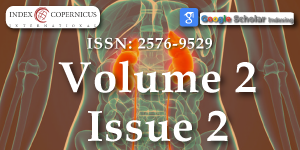Emphysematous pyelonephritis – A case series from a single centre in Southern India
Main Article Content
Abstract
TEmphysematous pyelonephritis (EPN) is a rare but potentially life-threatening necrotizing renal parenchymal infection characterised by the production of intra-parenchymal gas. The approach and the management of emphysematous has changed dramatically over the last two decades with the advent of computed tomography (CT)-based diagnosis and advances in antibiotic therapy as well as multidisciplinary intensive care of sepsis leading to an overall decline in mortality rates to 20-25%. The previously standard treatment for EPN which included nephrectomy of the affected kidney has been replaced by minimally invasive and nephron sparing surgery with better patient outcomes. We present our case series of 12 patients with EPN over a short period of two years treated at our tertiary care centre in South Western India.
Article Details
Copyright (c) 2018 Alaparthi P. et al.

This work is licensed under a Creative Commons Attribution 4.0 International License.
The Journal of Clinical Nephrology is committed in making it easier for people to share and build upon the work of others while maintaining consistency with the rules of copyright. In order to use the Open Access paradigm to the maximum extent in true terms as free of charge online access along with usage right, we grant usage rights through the use of specific Creative Commons license.
License: Copyright © 2017 - 2025 |  Open Access by Journal of Clinical Nephrology is licensed under a Creative Commons Attribution 4.0 International License. Based on a work at Heighten Science Publications Inc.
Open Access by Journal of Clinical Nephrology is licensed under a Creative Commons Attribution 4.0 International License. Based on a work at Heighten Science Publications Inc.
With this license, the authors are allowed that after publishing with the journal, they can share their research by posting a free draft copy of their article to any repository or website.
Compliance 'CC BY' license helps in:
| Permission to read and download | ✓ |
| Permission to display in a repository | ✓ |
| Permission to translate | ✓ |
| Commercial uses of manuscript | ✓ |
'CC' stands for Creative Commons license. 'BY' symbolizes that users have provided attribution to the creator that the published manuscripts can be used or shared. This license allows for redistribution, commercial and non-commercial, as long as it is passed along unchanged and in whole, with credit to the author.
Please take in notification that Creative Commons user licenses are non-revocable. We recommend authors to check if their funding body requires a specific license.
Hooton T. Urinary tract infection in adults. In: Floege J, Johnson RJ, Feehally J, editors. Comprehensive Clinical Nephrology, 4th Ed. Mosby Elsevier Inc: Philadelphia. 2010; 638-639. Ref.: https://goo.gl/FAwqb6
Falagas ME, Alexioua VG, Giannopoulou KP, Siempos II. Risk factors for mortality in patients with emphysematous pyelonephritis: A meta-analysis. J Urol. 2007; 178: 880-885. Ref.: https://goo.gl/Tng33g
Huang JJ, Tseng CC. Emphysematous pyelonephritis: Clinico-radiological classification, management, prognosis and pathogenesis. Arch Intern Med. 2000; 160: 797-805. Ref.: https://goo.gl/P8cxbU
Schultz EH, Klorfien EH. Emphysematous pyelonephritis. J Urol. 1962; 87: 762-766. Ref.: https://goo.gl/AeF7S7
Pontin AR, Barnes RD. Current management of emphysematous pyelonephritis. Nat Rev Urol. 2009; 6: 272-279. Ref.: https://goo.gl/RFKEzT
Shokier AA, El-Azad M, Mohsen T, El-Diasty T. Emphysematous pyelonephritis. A 15-year experience with 20 cases. Urology. 1997; 49: 343-346. Ref.: https://goo.gl/RZ7yzD
Huang JJ, Chen KW, Ruann MK. Mixed acid fermentation of glucose as a mechanism of emphysematous urinary tract infection. J Urol. 1991; 146: 148-151. Ref.: https://goo.gl/WgHjqy
Sharma PK, Sharma R, Vijay MK, Tiwari P, Goel A, et al. Emphysematous pyelonephritis: Our experience with conservative management in 14 cases. Urol Annall. 2013; 5: 57-62.
Fatima R, Jha R, Muthukrishnan J, Gude D, Nath V, et al. Emphysematous pyelonephritis : A single centre study. Indian J Nephrol. 2013; 23: 119-124. Ref.: https://goo.gl/2pMJWb
Misgar RA, Mubarik I, Wani AI, Bashir MI, Ramzan M, et al. Emphysematous Pyelonephritis: A 10 year experience with 26 cases. Indian J Endocrinolo Metab. 2016; 20: 475-480. Ref.: https://goo.gl/rpN24q
Kapoor R, Muruganandham K, Gulia AK, Singla M, Agrawal S, et al. Predictive factors for mortality and need for nephrectomy in patients with emphysematous pyelonephritis. BJU Int. 2010; 165: 986-989.
Dhabalia JV, Neliviqi GG, Kumar V, Gokhale A, Punia MS, et al. Emphysematous pyelonephritis: Tertiary care centre experience in management and review of the literature. Urol Int. 2010; 85: 304-308. Ref.: https://goo.gl/m5Y3vi
Aswathamam K, Gopalakrishnan G, Gnanaraj L, Chacko NK, Kekre NS, et al. Emphysematous pyelonephritis: outcome of conservative management. Urology. 2008; 71: 1007-1009. Ref.: https://goo.gl/K2RCKi
Somani BK, Nabi G, Thorpe P, Hussey J, Cook J, et al. Is percutaneous drainage the new gold standard in the management of emphysematous pyelonephritis? Evidence from a systematic review. J Urol. 2008; 179: 1844-1849. Ref.: https://goo.gl/dJBBzx
Aboumarzouk OM, Hughes O, Narahari K, Coultard R, Kynaston H, et al. Emphysematous pyelonephritis: Time for a management plan with an evidence-based approach. Arab J Urol. 2014; 12: 106-115. Ref.: https://goo.gl/foZQwD

